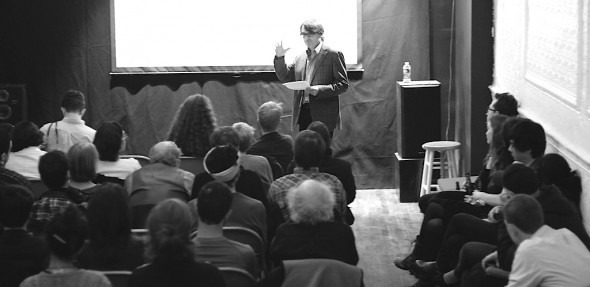
Film scholar Richard Allen introducing Gardner’s Forest of Bliss.
The lively debate that followed a recent UnionDocs screening of Robert Gardner’s Cheap Forest of Bliss made it clear that the world of documentary film is nowhere close to having reached a consensus regarding the right way to approach ethnography. The discussion centered on the well-worn concerns of the genre—objectivity vs. subjectivity, insider vs. outsider, and observational vs. interactive.
The debate took a unique turn, though, when two of the panelists voiced their disapproval of the methods through which Gardner represents Hindu ritual in the film. Interestingly enough, it was the techniques that Gardner appropriated in order to counteract the problematic history of ethnographic filmmaking that those panelists found troubling.
Pradosh Mishra, a Fulbright Fellow from the city of Varanasi, expressed concern that the film’s narrow scope would lead audiences, particularly Western ones, to believe that the world of the film is reality. Mishra, as well as Brooklyn College film professor Annette Danto, believed that the film’s lack of subtitles and voice-over narration left too much untranslated and, in doing, oversimplified the true diversity of Hindu ritual and life in Varanasi.
In contrast, film scholar Richard Allen and professor of studio art at the University of Connecticut Kathryn Myers believed that it was precisely those features of the film that worked to do the subject justice. In introducing the film, Allen argued that, “the film is of interest as a work and is remarkable as a work for the ways in which it abandons the explanatory voice-over narration that would label, explain, and organize these rituals in an expository fashion.” Allen, as well as many others in the audience, saw the film’s “abandonment of any attempt to be systematic or objective in its representation,” as a self-conscious acknowledgment of the limitations of filmic ethnography.
What was subjective and self-conscious to one viewer was seen as deceptively objective and misguided to another. And what some found problematic, others saw as the resolution of old problems. In the end, the only thing that was clear was that there can be no one way to read a film.
Read the full transcript from the post-screening discussion below.
Pradosh Mishra: I am Pradosh Mishra. I am on a Fulbright Fellowship here from Varanasi. I’ve been living in Varanasi from 15 years, from 1997 onwards. For the first time viewers of this film, let me tell you, this is one side of the coin. OK? We have a beautiful city. We have a lot more stories to tell. And we have a lot more shades than what you have seen. Just to say a few things, we have got about 85 ghats [def: series of steps leading down to a body of water. In this case, the Ganges.], out of which only 1 ghat was shown. Life only ends there. But, the 84 other ghats, life still is living. So, while looking at this movie, I think you mustn’t take into consideration this is the entire thing of Varanasi. This is only a very tiny but very powerful segment. He has not focused on everything. When we look at the whole perspective of what he has shown, he has only taken one particular thing—the Manikarnika ghat—which has a uniqueness of having cremation around the clock. Fire never ends there. And when you approach by boat, you see bodies burning in the process of cremation as a ritual every time.
I had a bit of a problem with him intentionally choreographing a few segments, which are looking natural, but they are choreographed, because I am an insider. I am not someone from outside looking in at the city.
Another thing, when you start looking at the movie, it begins with ‘Benares.’ If it was made in 1985, we still don’t call it Benares. Benares is a terminology which is used to describe the city of the British. And he has not defined that. What we are seeing is the life of Varanasi. So I think a little more research could have been done in that aspect. When we are looking at this particular culture from one particular perspective, it needs to be more clarified.
You know, so, not having a kind of narration, I think he has not done justice with the movie. However, the picture is very well captured. It was tremendous at certain segments, an extraordinary capture of activities. But at times, I think it is not that powerful. For me it’s kind of a mixed bag of presentation.
Annette Danto: My name is Annette Danto. I spent two semesters in India on two separate Fulbright Fellowships for documentary filmmaking. I also teach film and television production at Brooklyn College.
There was a film that won the Oscar for best documentary, I think it was two years ago, called Born into Brothels. That film was very unpopular in India. People found that it did not really give a full sense of what some of the challenges are in terms of educating children in some of the low-income neighborhoods in different parts of urban India. This film [Forest of Bliss] is also not popular in India. I’ve discussed it with many (?) colleagues and filmmakers there. It received the same kind of reception as Born into Brothels and also Slumdog Millionaire, which are films that are very, very popular outside of India because they exoticize, they mystify—they don’t really give a full context to the issues that are introduced in those films. I am not an expert on funeral rituals in India, but I know there are many regional variations. There are many caste variations. There are variations based on someone’s status on the community, the job that they held. So this film doesn’t give enough information. You’re not even sure what the sequences are. I mean, there are apparently three or four different stages before the person is cremated. There are a series of rituals, during the cremation, and afterwards. There are different ways of cremation. So the film doesn’t give a context. I think it’s very problematic. I agree with you, really, completely. And I haven’t been to Varanasi.
The other thing I wanted to say was for about 25 to 30 years, documentary filmmakers have been having this ongoing discussion about media ethics and issues of representation, issues of consent. You know, “How involved are the people you are filming in the actual process?” Here, in Forest of Bliss, there was really no collaboration. The camera was pointed at people who had absolutely no understanding of the implications of this film, of the implications of these images that are now being shown all over the world as a representation of Hindu ritual and the city of Varanasi. So, I think it’s quite problematic.





